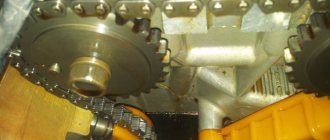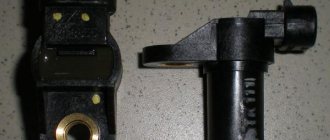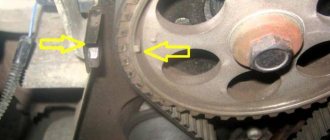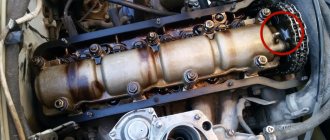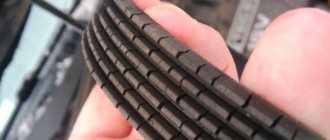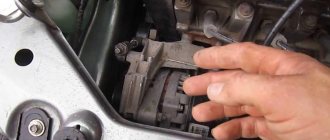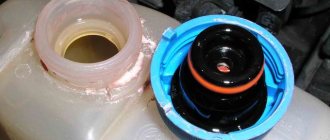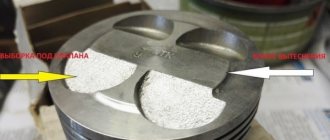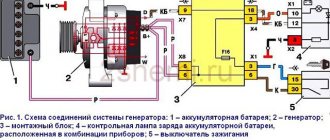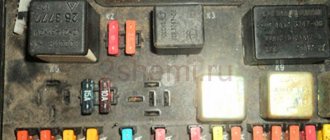The VAZ 2108 is the first vehicle produced in the USSR using front-wheel drive. We can say that this model became revolutionary, unlike the old model of cars in the domestic automobile industry, amazing car connoisseurs. That is why the VAZ-2108 was very popular among car enthusiasts.
This car, like all its predecessors, has an engine with a timing belt. More information about what a timing belt is, what analogues it has and how to change the part in case of breakdown will be discussed in this article.
Timing belts for VAZ-2108
The timing belt is a special part that makes it possible to combine the action of two shafts - the crankshaft and the camshaft. By using the part, the technical characteristics of the engine are improved, and, therefore, the quality of the car itself increases.
The standard timing belt on a VAZ-2108 with an 8-valve engine has article number K015521.
Moreover, it is equipped with a roller, through which it is possible to tension the belt and secure it in the desired position. The price for such a design ranges from 500 to 2000 rubles. The cost depends on the manufacturer and region of residence of the car owner.
The table below shows analogues of timing belts with article numbers and approximate prices. Before purchasing, you should know how many teeth there are on the belt.
| Analogue | vendor code | price, rub. |
| CONTITECH | 111Z | 300 |
| BOSCH | 1987949139 | 400 |
| GATES | K015521xs | 500 |
It is worth noting that prices are for the belt only. However, the price does not include other spare parts used to secure the part. Thus, when replacing a timing belt, you will need to increase costs and calculate possible costs in advance.
https://youtu.be/https://youtu.be/Z_pJOrI3-Hk
_
Replacement features
The operation is not a complicated process, but requires care and concentration, since mistakes can lead to a major overhaul of the power unit. The car is placed on a level area. Wheel chocks should be installed under the wheels to prevent the machine from rolling away.
Replacing the timing belt on a VAZ 2108 engine is done as follows:
- It is necessary to remove the drive protection and the generator drive belt from the crankshaft pulley.
- You should unscrew the pulley bolt, remove it and return the bolt.
- It is necessary to remove the rubber plug from the clutch housing hatch. Next, rotate the crankshaft until the mark on the crankshaft flywheel aligns.
- The matching of the installation marks is checked.
- Loosen the tension roller fastenings and remove the timing belt in the following sequence: From the camshaft pulley.
- From the video.
- From the pump pulley.
- From the crankshaft pulley.
Note! When the timing belt is removed, do not rotate the crankshaft, because This can lead to bent valves and costly engine repairs.
Replacing the timing belt
On average, owners of a VAZ-2108 with an injector engine replace the timing belt almost every 75 thousand kilometers of the car. Sometimes this figure is lower due to premature wear. This happens because car owners install low-quality timing belts.
Thus, after approximately 70-75 thousand kilometers, the belt may wear out or completely rupture. In this case, a replacement will be required. To get started, you should stock up on the necessary tools, including:
- Socket wrench;
- Open-end wrench;
- 10.8 mm head;
- Thick screwdriver.
You will also need to purchase a new timing belt and tensioner pulley.
Belt tension
If, after turning the crankshaft, the installation marks coincide, the final tension of the timing belt is carried out. To do this, the drive uses a tension roller, which is mounted on an eccentric. You can turn it with a wrench or a special wrench, it depends on the tension mechanism. If the roller has a special nut, turn it clockwise with a wrench, then fix the nut on the roller axis. If the roller has two holes instead of a tension nut, tension is performed using a special wrench.
When such a key is missing, you can insert two bolts of suitable diameter into the holes. Next, insert a powerful screwdriver between them. By turning it clockwise, the timing mechanism drive is tightened. Correct tuning and adjustment of the timing drive is important; this will ensure achievement of the characteristics of the power unit, which are guaranteed by the engine manufacturer. If something is done incorrectly, the timing belt slides towards the engine and may break, which will lead to an emergency stop of the engine. To check the correct tension of the timing belt, turn it (twist) around its axis with two fingers, after which it should return to its original position.
Types, characteristics and applicability of VAZ timing belts
1 — crankshaft toothed pulley 2 — coolant pump toothed pulley 3 — VAZ 2110 tension roller 4 — rear protective cover 5 — camshaft toothed pulley 6 — VAZ 2110 toothed belt
A - mounting lug on the rear protective cover B - mark on the camshaft pulley VAZ 2110 C - mark on the oil pump cover D - mark on the crankshaft pulley
On the engines of the “classic” VAZ family (models 2101-2107), the gas distribution mechanism drive was built on the basis of a metal chain. It was only in the VAZ-2105 model that a rubber belt was used for the first time, which, however, did not live up to expectations and was not widely used (although there are quite a few Fives with belts on the roads today). A completely belt transmission of torque to the camshaft appeared on the VAZ-2108 model, and subsequently the chain was not used on cars of the Volzhsky Automobile Plant. The timing belt is used on VAZ-2108, 2109, 21099, all models of the tenth family, as well as on all current and discontinued Lada models (Kalina, Priora, Granta).
The VAZ timing belt must have certain characteristics that are specified in TU 38.1051912 “Toothed belts for VAZ engines.” Let us immediately note that in general the belts for different VAZ models have the same design and differ only in size. Therefore, when purchasing a new belt, it is necessary to take into account the model and modification of the engine installed in the car.
The timing belt for cars of the Volzhsky Automobile Plant is made of rubber, and two types of materials are used:
The strength and reliability of the belt is increased by the thread cord located inside it. Due to the presence of cord, when cracks and tears appear, the belt does not break immediately, but delaminates and becomes frayed, and is completely destroyed only with excessive wear and under significant loads.
The main feature of the timing belt is the presence of teeth on its inner side, with the help of which it engages with the toothed pulleys of the crankshaft, camshaft and water pump. Today the market offers two types of timing belts, which differ in tooth shape:
Belts with involute teeth are a traditional solution, which, despite some disadvantages, is still very widely used in VAZ cars. The profile of the teeth of such a belt is made in the form of a trapezoid, the sides of which are rounded (or, to put it correctly, outlined along the involute of a circle, hence the name of this profile). Involute gearing provides good load transfer, but it leads to rapid wear of belt teeth and gears.
Belts with a semicircular profile are a more modern solution, which has not yet been practically mastered by domestic manufacturers of timing belts for VAZ cars. Teeth with a semicircular profile resist wear better, so such a belt lasts longer and is more reliable; semicircular teeth are less likely to be cut off by pulleys when overloaded and are generally more durable.
Timing belts for VAZ cars are offered today by a large number of manufacturers. BRT belts (JSC BalakovRezinoTekhnika) are standard on cars from Tolyatti; these same belts are widely represented in the secondary market. However, a wider range and choice of belts are offered by foreign manufacturers - Bosch (Germany), Gates (Poland), Dayco (Italy), Roulunds (Denmark), Lemforder (Germany), Contitech (Germany), Hanse (Czech Republic), Finwhale (Germany and Switzerland) and others.
It is very important to know and understand!
In conclusion, it is worth saying that a timing belt break leads to a major overhaul of the entire engine. Because this is where the valves and pistons hit, and they begin to bend. That is why you should check the part at a certain interval of time in order to immediately identify defects and malfunctions; if they exist, immediately replace the timing belt itself and all components, do not wait until something irreparable happens. And also correctly set all the marks on the VAZ 2109 timing belt, and carry out the tension correctly. In another case, it can scroll, and if it is too tight, it will easily break off, while having a strong impact on the rest of the engine. Even a novice driver can perform all the work presented; the main thing is to study everything carefully and set the marks correctly so that there is no malfunction of the gas distribution mechanism. After all, the good operation of the car engine will depend on this.
How to properly check the rollers for serviceability?
Experienced car owners advise checking the serviceability of the rollers as follows:
- The first step is to remove the cover from the timing belt;
- Then start the engine;
- Observe the movement of the belt;
- You also need to listen, if you hear a whistle, grinding, squeaking, then most likely the rollers are faulty;
- Inspect the bearing bracket with the engine turned off;
- Check the belt for play; if there is any, this is a consequence of a malfunction of the roller or its incorrect setting;
- Check the roller for abrasion;
- Check to see if there is a grinding noise when the roller rotates (to do this, remove the belt and turn the roller several times).
- You can check the operation of the rollers by inspecting the belt itself. If bites are found on it, this indicates a malfunction of the tension rollers. In this case, they must be urgently replaced.
Experienced car owners advise resorting to the following trick:
If you hear a creaking sound when the belt is operating, do not immediately replace the rollers! You can apply WD-40 lubricant to the inside of the belt. If the creaking fails, then the problem was belt wear. As a result, only it can be replaced.
You should also do some preparatory work:
- prepare the necessary tools;
- purchase consumables.
To carry out technical work on replacing timing rollers, you will need the following tools and consumables:
- Set of car spanners;
- A set with a ratchet wrench, a set of replacement heads for it (needed when a modified timing system shield is installed);
- Automotive screwdriver set;
- New consumables;
- Lubricant mixture;
- Rags.
To ensure that the car owner does not receive any injuries, he must also comply with the necessary safety precautions. It's pretty simple! But following it will allow you to protect yourself from unwanted injuries.
Safety precautions when carrying out technical work on the timing system:
- It is necessary to wear double-layer gloves;
- Replace consumables only with the engine turned off;
- When removing the timing rollers, they should be held with your hand, otherwise they may jump off their seat and hit the car owner in the face;
- Carry out all work in a well-lit place;
- When changing timing system consumables, you should strictly follow the step-by-step instructions.
Compliance with all the points described above will allow all technical work to be completed within 1 - 1.5 hours.
How to install the rollers correctly in place?
Not only the operation of the timing belt, but the operation of the entire engine as a whole will depend on how correctly the rollers are installed.
In order to correctly install the timing rollers, you must follow the following instructions:
- The first step is to position the tension roller so that the technical holes for a special key are on the outside of the roller.
- The second step is to use a special key to adjust the position of the roller.
- Then install the timing belt on it.
- Then perform a couple of revolutions of the belt to make sure that the roller rotates smoothly on the bushing. During its operation, it should not make creaks, rattles, or metal friction should be felt.
- When tightening this part, it will be useful for inexperienced motorists to use the level from the repair kit. When tightening the bolts, place a level against the roller and, if necessary, adjust its position. It should be installed at 90 degrees. Otherwise, when the engine is running, it may damage its seat, which will require expensive repairs.
If you follow the instructions described above, you should take into account: for adjusting the tension rollers, there are special technical marks on the modified timing system plate. They should be used to adjust their position. The car comes with a standard panel from the factory, which does not have any technical data printed on it.
Features of the operation of the timing belt in VAZ cars
The timing belt is subjected to serious loads during operation - heat, oil ingress, stretching, wear due to constant contact with pulleys, etc. In winter, when the car is stopped, the belt freezes, loses elasticity and suffers even more when starting the engine. In hot summers, on the contrary, the belt heats up significantly, which leads to its intensive aging. Therefore, the timing belt must be changed regularly, otherwise one day it will start to slip or even break, and this will have the most dire consequences for the engine.
Any damage to the timing belt is accompanied by a mismatch in the operation of the timing belt and timing belt, which at best simply requires a new engine adjustment, and at worst - serious repairs to the piston group, timing belt, cylinder head and other parts. In particular, a timing belt rupture leads to an almost instantaneous stop of the camshaft, which means that the intake and exhaust valves are locked in the position they occupied before the breakdown. However, in this case the pistons continue to move in the cylinders, so when they rise to TDC they bend the valves, and in the worst case, they are simply broken by the valves. As a result, the engine stops and requires expensive repairs.
It should be noted here that not all VAZ engines break down when the timing belt breaks. In the line of VAZ engines there are models (for example, the 1.5-liter in the VAZ-2109), the pistons of which have recesses for the intake and exhaust valves - they are not afraid of camshaft stopping. But for most VAZ car engines, timing belt rupture poses a serious threat.
In the vast majority of cases, rupture or cutting of teeth (which can also cause serious damage to the engine) occurs after the belt has reached the end of its life; a new timing belt cannot simply break. Today, most manufacturers set the service life of the belt within 50-60 thousand km of vehicle mileage. After this period, the timing belt must be replaced, regardless of its condition. That is, even if the belt looks good outwardly and has no visible damage or serious wear, it still needs to be changed no later than after 60 thousand km.
Replacing the timing belt in VAZ cars is accessible to the average car owner and generally does not present any difficulties.
Timing belt, what is it and what is it for?
The gas distribution mechanism (GRM) is one of the two basic mechanisms of a car engine (the second is the crank).
Using the example of the gas distribution mechanism of engine 21083 of VAZ 21083, 21093, 21099 cars, we will figure out what this device is, what it is for, what it looks like and how it works.
What is a gas distribution mechanism and why is it needed?
The engine gas distribution mechanism is a system that allows for the filling of the cylinders with a combustible fuel mixture in accordance with the strokes and the subsequent release of gases formed as a result of the combustion of this mixture.
How does the timing belt of engine 21083 work?
The essence of the timing mechanism is the timely opening/closing of valves depending on the current engine stroke (piston position in the cylinder). For this purpose, the position of the camshaft and crankshaft is synchronized. They are aligned relative to each other according to marks (see “Timing marks for engine 21083”).
Scheme "Timing device for engine 21083"
Diagram of the gas distribution mechanism (GRM) of engine 21083 of VAZ 21083, 21093, 21099 cars
Parts of the gas distribution mechanism of engine 21083
Camshaft
Installed in the cylinder head on five supports. It is driven by a belt drive from the crankshaft. See "2108 Camshaft".
Camshaft pulley
The gear pulley is attached to the front of the camshaft using a bolt. To prevent rotation, the connection has a key.
Camshaft bearing housing
Two-part. The front is smaller, the back is larger. The seats for the camshaft journals (bearings) are machined together with the pastels in the cylinder head. See "2108 Camshaft Bearing Housing".
Valves
The intake and exhaust valves serve for periodic opening and closing of the intake and exhaust ports. They are located in the cylinder head obliquely in a row. The intake valve plate is larger, the exhaust valve is smaller.
Valve guides
Cast iron, pressed into the cylinder head. Retained with retaining rings.
Valve seal
Made from fluorine rubber. Installed on the guide sleeve. Compresses the valve stem (spring) and prevents oil from penetrating into the mixing chamber.
Diagram “Timing drive device for engine 21083”
Scheme "Device of the gas distribution mechanism (GRM) drive of engine 21083 of VAZ 21083, 21093, 21099"
Notes and additions
In the 21083 engine, the camshaft is located at the top. There are engines with a lower camshaft.
Source
